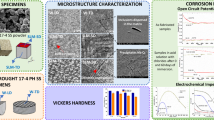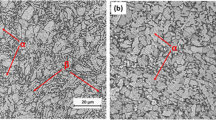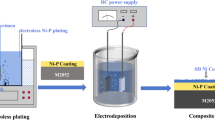Abstract
The corrosion behavior of two types of low-carbon steel (denoted steel A and steel B) in H2S/CO2 was investigated through immersion tests, and the effect of Ti microalloying on the corrosion mechanism was analyzed. The microstructures, corrosion kinetics, corrosion surface morphologies, corrosion phases, cross-sectional morphologies and elemental distributions of the materials were studied by scanning electron microscopy (SEM), transmission electron microscopy (TEM), electron backscatter diffraction (EBSD), energy-dispersive spectroscopy (EDS), x-ray diffraction (XRD) and electron probe microanalysis (EPMA). The results showed that the corrosion rate of steel B with Ti microalloying was lower than that of steel A; the amount and formation rate of corrosion products in these two materials were different. As the immersion time increased, the corrosion products changed from iron-rich mackinawite to sulfur-rich pyrrhotite. In the early stage of corrosion, the corrosion products were primarily mackinawite, which controlled the corrosion phase through the entire process. After 384 h of immersion, pyrrhotite was observed, which can effectively protect the steel substrate, providing excellent corrosion resistance. The corrosion products in steel B with Ti microalloying were more compact than those in steel A. Moreover, Ti enrichment in the oxide film was observed in steel B, which can further improve its corrosion resistance. The results from this study can provide an important reference for the oil and gas industry.












Similar content being viewed by others
References
S. Nešić, Key Issues Related to Modelling of Internal Corrosion of Oil and Gas Pipelines—A Review, Corros. Sci., 2007, 49, p 4308–4338
M.A. Islam and Z.N. Farhat, Characterization of the Corrosion Layer on Pipeline Steel in Sweet Environment, J. Mater. Eng. Perform., 2015, 24, p 3142–3158
X.B. Shi, W. Yan, W. Wang et al., Novel Cu-Bearing High-strength Pipeline Steels with Excellent Resistance to Hydrogen-Induced Cracking, Mater. Des., 2016, 92, p 300–305
Z.Y. Liu, X.Z. Wang, R.K. Liu et al., Electrochemical and Sulfide Stress Corrosion Cracking Behaviors of Tubing Steels in a H2S/CO2 Annular Environment, J. Mater. Eng. Perform., 2014, 23, p 1279–1287
J. Ding, L. Zhang, M. Lu et al., The Electrochemical Behavior of 316L Austenitic Stainless Steel in Cl− Containing Environment under Different H2S Partial Pressures, Appl. Surf. Sci., 2014, 289, p 33–41
M. Javidi, S.M.S. Haghshenas, and M.H. Shariat, CO2 Corrosion Behavior of Sensitized 304 and 316 Austenitic Stainless Steels in 3.5 wt% Nacl Solution and Presence of H2S, Corros. Sci., 2020, 163, p 108230
W. He, O.Ø. Knudsen, and S. Diplas, Corrosion of Stainless Steel 316L in Simulated Formation Water Environment with CO2–H2S–Cl, Corros. Sci., 2009, 51, p 2811–2819
Q.Y. Wang, Y. Behnamian, H. Luo et al., Anticorrosion Performance of Chromized Coating Prepared by Pack Cementation in Simulated Solution with H2S and CO2, Appl. Surf. Sci., 2017, 419, p 197–205
K.X. Liao, F.L. Zhou, X.Q. Song et al., Synergistic Effect of O2 and H2S on the Corrosion Behavior of N80 Steel in a Simulated High-Pressure Flue Gas Injection System, J. Mater. Eng. Perform., 2020, 29, p 155–166
S.J. Dong, G.S. Zhou, X.X. Li et al., Comparison of Corrosion Scales Formed on KO80SS and N80 Steels in CO2/H2S Environment, Corros. Eng. Sci. Technol., 2011, 46, p 692–696
H.W. Wang, P. Zhou, S.W. Huang et al., Corrosion Mechanism of Low Alloy Steel in NaCl Solution with CO2 and H2S, Int. J. Electrochem. Sci., 2016, 11, p 1293–1309
C. Yu, P. Wang, and X.H. Gao, Corrosion Behavior and Kinetics of Early Stages of Low Alloy Steel under H2S/CO2 Environment, Int. J. Electrochem. Sci., 2015, 10, p 6820–6832
R. Rihan, M.N. Zafar, and L. Ai-Hadhramil, A Novel Emulsion Flow Loop for Investigating the Corrosion of X65 Steel in Emulsions with H2S/CO2, J. Mater. Eng. Perform., 2016, 25, p 3065–3073
M.A. Lucio-Garcia, J.G. Gonzalez-Rodriguez, M. Casales et al., Effect of Heat Treatment on H2S Corrosion of a Micro-Alloyed C-Mn Steel, Corros. Sci., 2009, 51, p 2380–2386
W.F. Li, Y.J. Zhou, and Y. Xue, Corrosion Behavior of 110S Tube Steel in Environments of High H2S and CO2 Content, J. Iron. Steel Res. Int., 2012, 19, p 59–65
D.P. Li, L. Zhang, J.W. Yang et al., Effect of H2S Concentration on the Corrosion Behavior of Pipeline Steel under the Coexistence of H2S and CO2, Int. J. Min. Met. Mater., 2014, 21, p 388–394
Y.S. Choi, S. Nesic, and S. Ling, Effect of H2S on the CO2 Corrosion of Carbon Steel in Acidic Solutions, Electrochim. Acta, 2011, 56, p 1752–1760
B.F.M. Pot, S.D. Kapusta, and R.C. John, Improvements on De Waard-Milliams Corrosion Prediction and Application to Corrosion Management, Corrosion, 2002, 4, p 1–1
P.Y. Wang, J. Wang, S.Q. Zheng et al., Effect of H2S/CO2 Partial Pressure Ratio on the Tensile Properties of X80 Pipeline Steel, Int. J. Hydrogen Energy, 2015, 40, p 11925–11930
C. Plennevaux, J. Kittel, M. Frégonèse et al., Contribution of CO2 on Hydrogen Evolution and Hydrogen Permeation in Low Alloy Steels Exposed to H2S Environment, Electrochem. Commun., 2012, 26, p 17–20
L. Wei, X.L. Pang, and K.W. Gao, Effect of Small Amount of H2S on the Corrosion Behavior of Carbon Steel in the Dynamic Supercritical CO2 Environments, Corros. Sci., 2016, 103, p 132–144
E. Abelev, J. Sellberg, T.A. Ramanarayanan et al., Effect of H2S on Fe Corrosion in CO2-Saturated Brine, J. Mater. Sci., 2009, 44, p 6167–6181
X.H. Zhao, Y. Han, Z.Q. Bai et al., The Experiment Research of Corrosion Behaviour about Ni-based Alloys in Simulant Solution Containing H2S/CO2, Electrochim. Acta, 2011, 56, p 7725–7731
N.Y. Zhang, D.Z. Zeng, G.Q. Xiao et al., Effect of Cl− Accumulation on Corrosion Behavior of Steels in H2S/CO2 Methyldiethanolamine (MDEA) Gas Sweetening Aqueous Solution, J. Nat. Sci. Eng., 2016, 30, p 444–454
Y.F. Wang, G.X. Cheng, W. Wu et al., Effect of pH and Chloride on the Micro-mechanism of Pitting Corrosion for High Strength Pipeline Steel in Aerated NaCl Solutions, Appl. Surf. Sci., 2015, 349, p 746–756
B.A.F. Santos, R.C. Souza, M.E.D. Serenario et al., The Effect of Different Brines and Temperatures on the Competitive Degradation Mechanisms of CO2 and H2S in API, X65 Carbon Steel, J. Nat. Gas Sci. Eng., 2020, 103405, p 80
L.D. Wang, H.B. Wu, Y.T. Liu et al., Influence of Cr on Microstructure and Properties and CO2/H2S Corrosion Behavior of Q125 Grade Tube Steel, Mater. Sci. Technol., 2013, 21, p 8–14
H.B. Wu, L.F. Liu, L.D. Wang et al., Influence of Chromiumon Mechanical Properties and CO2/H2S Corrosion Behavior of P110 Grade Tube Steel, J. Iron. Steel Res. Int., 2014, 21, p 76–85
B.J. Dong, W. Liu, Y. Zhang et al., Comparison of the Characteristics of Corrosion Scales Covering 3Cr Steel and X60 Steel in CO2-H2S Coexistence Environment, J. Nat. Gas Sci. Eng., 2020, 103371, p 80
H.W. Wang, H.Y. Wang, X.H. Gao et al., Effect of Nb and Ti on Corrosion Characteristics of Low Alloy Steel in Supercritical CO2 Environment, Int. J. Electrochem. Sci., 2019, 14, p 10907–10919
H. Ali-Loytty, M. Hannula, M. Honkanen et al., Grain Orientation Dependent Nb-Ti Microalloying Mediated Surface Segregation on Ferritic Stainless Steel, Corros. Sci., 2016, 112, p 204–213
S. Sadeghpour, A. Kermanpur, and A. Najafizadeh, Influence of Ti Microalloying on the Formation of Nanocrystalline Structure in the 201L Austenitic Stainless Steel During Martensite Thermomechanical Treatment, Mat. Sci. Eng. A, 2013, 584, p 177–183
Z.G. Liu, X.H. Gao, L.X. Du et al., Corrosion Behavior of Low-Alloy Pipeline Steel Used for Pipeline at Vapor-Saturated CO2 and CO2-Saturated Brine Conditions, Mater. Corros., 2016, 67, p 817–830
ASTM Standard G1-03, Standard Practice for Preparing, Cleaning, and Evaluating Corrosion Test Specimens, ASTM International, West Conshohocken, PA, 2003
M.Y. Zhang, M. Li, S.F. Wang et al., Enhanced Wear Resistance and New Insight into Microstructure Evolution of In-situ (Ti, Nb)C Reinforced 316 L Stainless Steel Matrix Prepared Via Laser Cladding, Opt. Laser Eng., 2020, 106043, p 128
Q.L. Wu, Z.H. Zhang, X.M. Dong et al., Corrosion Behavior of Low-Alloy Steel Containing 1% Chromium in CO2 Environments, Corros. Sci., 2013, 75, p 400–408
A. Pfennig, P. Zastrow, and A. Kranzmann, Influence of Heat Treatment on the Corrosion Behaviour of Stainless Steels during CO2-sequestration into Saline Aquifer, Int. J. Greenh. Gas Con., 2013, 15, p 213–224
D. An, T.A. Griffiths, P. Konijnenberg et al., Correlating the Five Parameter Grain Boundary Character Distribution and the Intergranular Corrosion Behaviour of a Stainless Steel Using 3D Orientation Microscopy Based on Mechanical Polishing Serial Sectioning, Acta Mater., 2018, 156, p 297–309
Z.G. Liu, X.H. Gao, L.X. Du et al., Corrosion Behavior of Low-Alloy Pipeline Steel Exposed to H2S/CO2-Saturated Saline Solution, J. Mater. Eng. Perform., 2017, 26, p 1010–1017
Z.G. Liu, X.H. Gao, L.X. Du et al., Comparison of Corrosion Behaviour of Low-Alloy Pipeline Steel Exposed to H2S/CO2-Saturated Brine and Vapour-Saturated H2S/CO2 Environments, Electrochim. Acta, 2017, 232, p 528–541
F.X. Shi, L. Zhang, J.W. Yang et al., Polymorphous FeS Corrosion Products of Pipeline Steel Under Highly Sour Conditions, Corros. Sci., 2016, 102, p 103–113
M. Liu, J.Q. Wang, W. Ke et al., Corrosion Behavior of X52 Anti-H2S Pipeline Steel Exposed to High H2S Concentration Solutions at 90 °C, J. Mater. Sci. Technol., 2014, 30, p 504–510
D.W. Shoesmith, P. Taylor, M.G. Bailey et al., The Formation of Ferrous Monosulfide Polymorphs During the Corrosion of Iron by Aqueous Hydrogen Sulfide at 21 °C, J. Electrochem. Soc., 1980, 127, p 1007–1019
J. Banaś, U. Lelek-Borkowska, B. Mazurkiewicz et al., Effect of CO2 and H2S on the Composition and Stability of Passive Film on Iron Alloys in Geothermal Water, Electrochim. Acta, 2007, 52, p 5704–5714
Y.M. Qi, H.Y. Luo, S.Q. Zheng et al., Comparison of Tensile and Impact Behavior of Carbon Steel in H2S Environments, Mater. Des., 2014, 58, p 234–241
P.P. Bai, S.Q. Zheng, and C.F. Chen, Electrochemical Characteristics of the Early Corrosion Stages of API, X52 Steel Exposed to H2S Environments, Mater. Chem. Phys., 2015, 159, p 295–301
Acknowledgments
This work was supported by the China Postdoctoral Science Foundation (No. 2018M631761), the Fundamental Research Funds for the Central Universities (Nos. N182303030, N2023018), the Higher Educational Science and Technology Program of Hebei Province (Nos. QN2019317, ZD2020413) and the Natural Science Foundation of China (No. 61903072).
Author information
Authors and Affiliations
Corresponding author
Additional information
Publisher's Note
Springer Nature remains neutral with regard to jurisdictional claims in published maps and institutional affiliations.
Rights and permissions
About this article
Cite this article
Yu, C., Wang, H., Gao, X. et al. Effect of Ti Microalloying on the Corrosion Behavior of Low-Carbon Steel in H2S/CO2 Environment. J. of Materi Eng and Perform 29, 6118–6129 (2020). https://doi.org/10.1007/s11665-020-05077-1
Received:
Revised:
Published:
Issue Date:
DOI: https://doi.org/10.1007/s11665-020-05077-1




